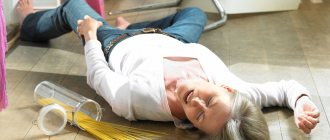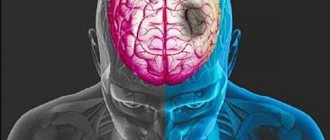To begin with, let's divide all seizures into generalized, when the whole body is subject to a convulsive attack, and local, when only one area is affected - for example, the calf muscle.
There are also tonic and clonic seizures. The first ones are more like not a cramp, but a spasm, in which the body seems to be frozen in one position. A classic example of a tonic seizure is opisthotonus in tetanus. Such seizures are rare and are always caused by a serious illness: tetanus, neuroinfection, brain tumors.
The second option is clonic convulsions, in which the body makes frequent chaotic movements, that is, it beats in a typical convulsive seizure, as most of us imagine it.
This option can be encountered much more often in life - these include febrile convulsions when the temperature rises in young children, and epileptic seizures in people of any age. If your leg is cramped or your biceps is constantly twitching, this is unpleasant, but not dangerous.
If we are talking about generalized seizures, a person needs quick medical attention. Although neurologists like to repeat that a seizure is not as terrible as it looks from the outside.
Febrile seizures
The content of the article
This is a fairly common occurrence when it comes to children under 6 years of age. It is believed that every tenth child responds to a rise in temperature at least once in his life with a generalized convulsive seizure.
Typically the temperature is required to rise above 38.5 degrees. Then, in the still imperfect child’s brain, foci of pathological excitation arise, triggering many false signals to the muscles.
It looks scary, but in reality everything is not so dangerous: usually the seizure goes away within 2-3 minutes, but it can last 15, after which it ends as suddenly as it began.
And what is important - without causing any harm to the baby. Only seizures lasting more than half an hour require hospitalization and observation. You should also call a doctor if a child over 6 years of age, a teenager, or an adult develops seizures in response to a fever.
What to do? The only way you can and should help a child is to be close to him and make sure he doesn’t get hurt. Just in case, be prepared to turn your head to the side if vomiting begins. Forget about sticking spoons in your mouth.
In attempts to unclench your teeth and pull your tongue out of your mouth, you will only injure yourself and the child. Epilepsy subsequently develops in only 3% of children who have had febrile seizures, but it is still worth doing an electroencephalogram after recovery.
Prevention of spasm
Proper nutrition
In many cases, cramps occur due to a lack of one or another microelement in the body. Exhausting and strict diets will not only help you lose weight, but also undermine your health.
The following rules must be observed:
- Make sure you have enough potassium, calcium and magnesium in your body, as these elements are responsible for fluid circulation.
- As recommended by a specialist, take special multivitamins and minerals sold at pharmacies.
- Calcium is found in dairy products, but keep in mind that the lower the fat content, the less useful element it contains.
- Bananas must be present in your daily diet, as these fruits are rich in potassium. In addition, this microelement is found in poultry and fish meat. Don't forget about the diversity of your diet.
- To replenish magnesium, we think about nuts, spinach, oatmeal, bran, rye bread, herring and cheese.
The above products have good taste, so feel free to combine business with pleasure.
Local tonic convulsions
Muscle spasm in response to excessive physical activity or prolonged uncomfortable position is a common phenomenon. Professional athletes know this more than others, but even for ordinary fitness enthusiasts, sudden muscle pain causes many unpleasant emotions.
A cramped muscle is tense and hard to the touch, and the spasm is accompanied by severe pain. In addition to the calf muscles, convulsive spasms affect the muscles of the neck, and sometimes the muscles of the thigh and forearm can be affected. Usually, local tonic convulsions go away on their own within 5-10 minutes, but it’s still better not to endure the pain.
There is a simple scheme of actions that will help return the muscle to its normal state.
What to do? The most basic cause of spasm is a lack of microelements (primarily magnesium), excessive stress on an insufficiently warmed muscle, or prolonged stay in an uncomfortable position (this is what causes muscle spasms during sleep).
Therefore, people involved in physical exercise are recommended to take additional vitamin and mineral complexes, eat dried apricots before training, avoid dehydration, and most importantly, devote enough time and effort to warming up to “warm up” the muscles.
If a spasm does occur, there are techniques for local impact on the muscle. For example, if you have a spasm in the calf muscles, you need to stretch your leg forward as much as possible and strongly pull your foot towards you.
Causes of muscle spasm
The duration of the spasm, as a rule, is up to one minute, but in some cases it lasts longer - from five to fifteen minutes. More often, this phenomenon occurs at night, when the muscle is in a relaxed state.
A sharp spasm is characterized by acute pain in the leg. The affected muscle is hard to the touch and difficult to relax by kneading and rubbing. A single cramp in the calf muscle at night occurs for the following reasons:
- uncomfortable position during sleep;
- muscle overstrain (if, for example, there was physical stress before - long walking, running, prolonged sitting, carrying heavy objects or choosing inappropriate shoes);
- dehydration;
- low mobility;
- frequent stressful situations;
- regular hypothermia of the lower extremities.
In some cases, patients turn to the doctor to find out why a cramp in the calf muscle develops so sharply and without warning at night, causing a lot of inconvenience, leaving pain in the leg in the morning.
Regular spasms can be a consequence of a number of serious diseases or occur due to a lack of certain microelements necessary for the normal functioning of the body. To understand this in more detail, we recommend that you familiarize yourself with the information in table form.
Table. Causes of calf muscle cramps at night
| Cause | Explanation |
| Vitamin D deficiency | The vitamin takes an active part in the absorption of an important microelement - calcium. The shortage is usually observed among residents of northern regions, where solar activity is low. |
| Magnesium deficiency | More often, women encounter this condition during pregnancy. The fact is that an increased dose of magnesium is required for the formation of a child. With poor nutrition, a pregnant woman develops a deficiency of the substance. The element takes an active part in the transmission of nerve impulses to cells; its lack in the expectant mother causes leg cramps. |
| Iron deficiency | The condition is called iron deficiency anemia. It has been noted that with low hemoglobin, seizures are a common occurrence. |
| Endocrine system problems | Frequent cramps may indicate a dysfunction of the thyroid gland. Thus, insufficient production of the hormones thyroxine and triiodothyronine is one of the causes of short-term convulsions. |
| Diseases of the nervous system with damage to peripheral nerves | Pathology often leads to seizures; it is important to consult a neurologist. |
| Blood pooling in the calves or toes | Excessive activity during the day promotes intense blood circulation in the vessels of the legs. However, in the evening, when the intensity of exercise decreases sharply, blood can stagnate in the area of overworked fingers or calf muscles, which actively contract during the daytime. |
| Varicose veins | Another common cause of night cramps is varicose veins. It often appears in adulthood as a result of increased stress on blood vessels or due to genetics. Leg cramps are one of the first symptoms of this disease. |
| Flat feet | This disease, gradually developing, leads to damage to the nerves and blood vessels of the legs, which causes involuntary painful muscle contractions. There is no point in delaying the treatment of flat foot syndrome. |
A cramp in the calf muscle develops suddenly at night, sparing no one: neither women, nor men, nor even children. Why does a child experience muscle cramps?
Indeed, during a period of active growth, the baby may experience spasms during sleep and, if this happens, a consultation with a pediatrician is necessary. The reasons are different: lack of potassium, calcium, congenital foot defect or hypothermia. In any case, only a doctor, based on medical examinations, will name the exact circumstances that caused the baby’s painful condition.
Local clonic seizures
The reasons for periodic twitching of a particular muscle may be the most unexpected. For example, strong emotional experiences, stress, due to which excitation in our body begins to prevail over inhibition, various neuroses arise.
Or heredity, due to which we inherited easily excitable muscles. If your grandmother or mother often complained of local convulsions, this is from them. An unhealthy diet lacking essential micronutrients (crash diet) can also cause these symptoms. On the one hand, they do not cause serious concern, but they are not easy to get rid of.
What to do? The problem of muscle fasciculations becomes significant for the doctor and the patient when twitching occurs too often and really interferes with life. In this case, you should contact a neurologist. The course of treatment may take some time and include taking vitamins and minerals, medications that affect the nervous system (including sleeping pills and antidepressants), physiotherapy and massage.
Dangers behind the disease
Most often, spasms are observed in the calf muscle, located under the bend of the knee and stretching almost to the middle of the leg. It plays an important role in human life - it allows you to stand, walk, and perform various physical movements. The muscle is capable of significant stretching and contraction. It contains many blood vessels, nerve endings, plexuses of tendons and ligaments.
Now imagine that strong contractions occur in such a “rich” muscle! When the calf is in a relaxed state, the pain becomes so pronounced that the sleeping person jumps up sharply. When suffering, he tries to help himself with a massage, rubbing, or simple warm-up. It is usually difficult to immediately put the leg in order, so the victim unwittingly becomes a hostage to an unpleasant situation.
The spasm can affect the muscles of the foot, thigh and toes. In general, no matter where the leg cramps occur, there is always a load on the knee or ankle joint. Over time, this leads to negative changes in cartilage tissue and tendons.
Epileptic seizure
A seizure in epilepsy, or, as it is also called, status epilepticus, is perhaps the most striking example of what the average person imagines when they mention seizures.
The man suddenly pushes, his body contracts chaotically, incoherent wheezing is heard, foam comes out of the mouth. The picture is terrible, and the situation requires quick medical intervention. Surprisingly, just one intravenous injection quickly brings a person back to life.
What to do? The main task of a witness of status epilepticus is to ensure the safety of the unfortunate person so that he does not accidentally injure himself on surrounding objects. If possible, it is recommended to lay him on a soft surface and turn his head to the side so that vomit and foam do not enter the respiratory tract. Call an ambulance as quickly as possible.
If an attack occurs for the first time, it is very important to undergo a full examination as soon as possible. This may be the onset of one of the neurological diseases or a brain tumor.
ONLINE REGISTRATION at the DIANA clinic
You can sign up by calling the toll-free phone number 8-800-707-15-60 or filling out the contact form. In this case, we will contact you ourselves.
If you find an error, please select a piece of text and press Ctrl+Enter
The causes of seizures can be different:
- disturbance of the biochemical and/or electrolyte composition of the blood;
- physical exercise,
- uncomfortable shoes.
Night cramps often indicate the presence of venous disease. When the veins dilate, blood stagnates, which reduces the delivery of oxygen to tissues and stops the production of ATP, a universal source of energy in the body necessary for normal muscle function. The frequency of seizures also indicates the presence of varicose veins. If your legs begin to cramp more often, this indicates an increase in venous stagnation and tissue swelling.










